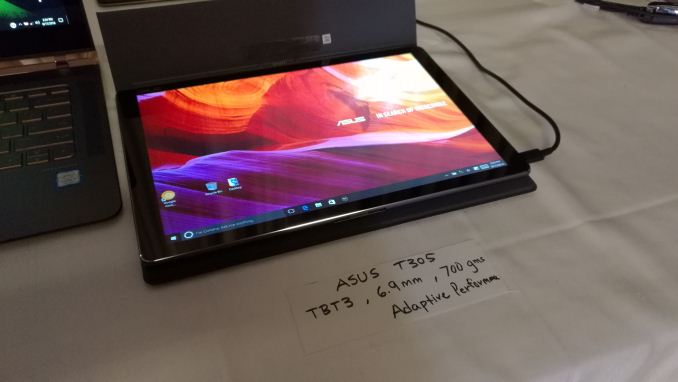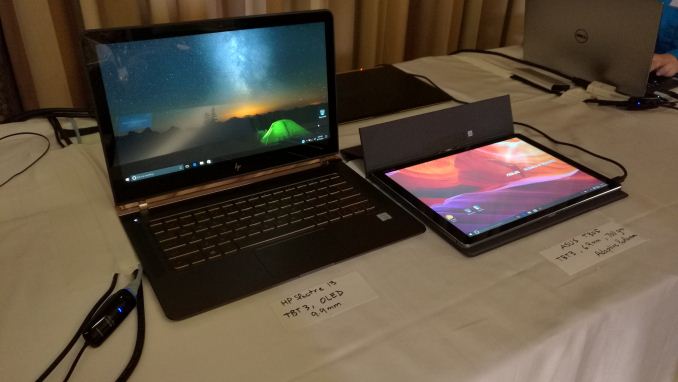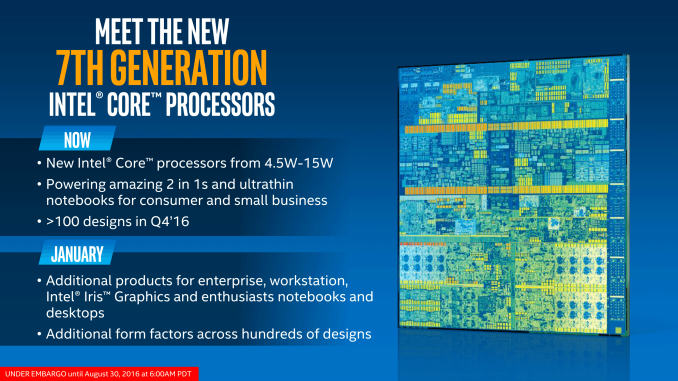Intel Announces 7th Gen Kaby Lake: 14nm PLUS, Six Notebook SKUs, Desktop coming in January
by Ganesh T S & Ian Cutress on August 30, 2016 9:00 AM EST- Posted in
- CPUs
- Intel
- 14nm
- Kaby Lake
- Gen 9
- Speed Shift
- Turbo Boost
Upcoming Hardware
Calling back to Computex, ASUS first announced a new Transformer device based on ‘Intel’s Next Generation’ processor. We knew it was Kaby Lake, but given the launch cycle for KBL it was understandable that the device was still a couple of months out and a work in process. At that point of the game the hardware specifications are typically squared away, and final touches are being made to the design ID as well as strong work on the software platform and ramping up the manufacturing aspect. We expect ASUS to launch their new Transformer products in due course.
At Intel’s pre-briefing for Kaby Lake, several systems were on display from HP all using the new processors. Specifications were not discussed, however devices with 4K panels and a variety of sizes were shown, including what looked like an upgraded Spectre, as well as a notebook with an OLED display.
This week is the annual IFA trade show in Berlin, which focuses on complete consumer electronics rather than components, as well as home appliances, IoT, and other things in-between. We have presentations and press events for a wide variety of companies including Acer, Samsung, Lenovo, Huawei, ZTE, and Sony, all of whom could be announcing something around Kaby Lake. (Qualcomm and AMD are also presenting at the show, but something tells me it isn’t to do with KBL.)
Explaining Why There’s No Desktop Parts Today
For the majority of enthusiasts, PC builders and gamers, questions about the time frame of the desktop processor launches, the benefits they bring and the pricing are swirling around the zeitgeist. Intel has confirmed with today’s launch that a wider array of Kaby Lake parts will be launched in January, including Iris graphics enabled processors, desktop parts, enterprise parts and workstation SKUs (vPro and Xeons, one would assume).
Despite the fact that this is still 14nm, one could assume that 14nm+ was focused on the small die parts first to improve yield before the larger desktop parts were produced, depending on how difficult the shift from 14 to 14+ actually was. There’s also the consideration about Intel’s product lines: Skylake on the desktop was only launched 12 months ago, and the next generation 10nm Intel product is - admittedly looking into a very foggy crystal ball - over a year away and will be mobile focused again as smaller dies are easier to make. Intel has to sufficiently space out its product stacks to ensure maximum profit, appease shareholders, but also give their customers a regular, expected update cycle. There’s a reason we don’t see the best product Intel could ever make on day one at unlimited expense.
Given that Intel has said that KBL is a similar IPC to SKL, it might be a bit worrying if desktop performance of the new parts is identical to the old ones, merely bumped up in frequency. Typically a small frequency bump mirrors a basic overclock; importantly however, if the pitch has been widened to allow a higher frequency, this could have a beneficial knock on effect for overclocking. Despite marketing efforts, Intel still limits overclocking to the two high-end SKUs, so how well Kaby Lake overclocks could prove important with desktop enthusiasts. If it overclocks better than Skylake, then we might be looking at the Skylake equivalent of the Haswell Refresh/Devil's Canyon. However if KBL offers the same OC frequency as SKL, and the same performance due to a similar IPC, then enthusiasts might not be interested. Ultimately Intel is going to market the new chips as a 3-5 year upgrade option for users still on Nehalem, Westmere and Sandy Bridge. This is ultimately where Intel believes most of the upgrade sales are coming from, rather than users jumping from Skylake.
The other factor is the motherboard side of the equation. We know that Kaby Lake on the desktop is to be accompanied by a new chipset launch as well, the 200-series, and typically if we were expecting a September launch then we would have seen motherboard examples at Computex. At the show, only MSI had an ‘unlabeled 200-series’ motherboard on show, which looked pretty identical to a Z170 product already on sale barring the design ID. We don’t yet know the benefits of the 200-series chipset over the 100-series line, and a release date in January would mean that motherboard manufacturers should now be in the final design steps for their major SKUs.
Saying ‘January’ as a launch date is quite vague. But, January has the annual CES event in Las Vegas during the first week after New Year, which is a common time to launch new CPUs after the holiday season finishes and people are ‘rested’.
Finally, it’s also worth noting that AMD is planning to enable widespread availability for their new Zen set of CPUs in Q1. So a January launch for desktop Kaby Lake could provide a more contested one for Intel. (If they also launch at CES, I need to start bulk ordering caffeine drips today. Goodbye sleep, it was nice knowing you. I may not be seen the rest of January.)
After all that, I’m pretty sure it’s pronounced Kay-bee Lake.














129 Comments
View All Comments
rhysiam - Tuesday, August 30, 2016 - link
They speculate on page 4 whether some retooling is required for the new 14nm+ process, and therefore whether perhaps only one or two fabs are going to be up and running early. If Intel has limited output it makes sense to direct early production to the valuable CPUs per mm2 of wafer... which is precisely these standard U and Y series processors (maybe some Xeon CPUs are higher earners, but the platform isn't ready yet). Mobile Iris Pro CPUs and most desktop processors require much more die area... meaning less output.All speculation at this point, but it is a possible answer to your question.
TEAMSWITCHER - Tuesday, August 30, 2016 - link
Ok, that makes sense. I always thought they were the same chips - with the Iris Pro features disabled. But if they are smaller dies then the bottom up approach could help to perfect the process before switching to the larger dies - potentially reducing the number of defective chips. Thanks.A5 - Tuesday, August 30, 2016 - link
It's yield and profit concerns. Doing the big chips first means they have to throw more of them away, which cuts down their profits.bryanlarsen - Tuesday, August 30, 2016 - link
Smaller chips yield dramatically better when defects are high. Imagine a die that holds 100 large chips and there are 100 defects on the die. Some of the chips will have more than one defect so there will be a few chips that are good, perhaps 15-25 or so. Now imagine that you are putting 200 smaller chips on the same die with 100 defects. You'll get at least 100 good chips, perhaps 110-120. So unless you can sell the large chip for 6-8x the cost of the small chip, it's more profitable to start with the small chips when defect rates are high.retrospooty - Tuesday, August 30, 2016 - link
The answer to almost any question like that is - they think it will be more profitable for them. They arent just thinking about the latest fastest thing, they are thinking about production, orders, volume and stock levels.quadrivial - Tuesday, August 30, 2016 - link
The answer is most likely ARM.Intel has zero competition in the high-end CPU front. People who can't wait will pay just as much for last-gen chips because that's all that's on the market. People who can wait won't mind a few months (and don't really have an option). In contrast, Intel lives in fear of Qualcomm, Samsung, or AMD announcing an ARM chip competitive with x86. Taking a more aggressive stance and coming to market as soon as possible is what Intel shareholders will want to see.
CaedenV - Tuesday, August 30, 2016 - link
True story. I can cry all I want about wanting a faster desktop chip, but the simple fact of the matter is that I will be forced to wait for Intel to release one because I am not tempted to move to AMD any time soon.But that the same time there are hundreds of schools debating between ARM and Intel chromebooks and chromeboxes, and whoever offers the lowest price is going to win the day. Releasing the smaller cheaper chips ASAP will prevent loosing those sales to ARM.
doggface - Wednesday, August 31, 2016 - link
Only problem with your theory is these chips are priced at well above the cost of a Chromebook processor. We are talking $2-400 for these chips. Arm processors can be less than $50. Not even the same league.Intel has ceded the low end of the market to Arm with the discontinuation of atom.
fanofanand - Wednesday, August 31, 2016 - link
Intel charges more for the chip than most chromebooks cost.Meteor2 - Wednesday, August 31, 2016 - link
None of this stuff (KBL) competes with ARM, it's aimed squarely at Apple. Broxton is the ARM competitor.